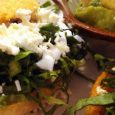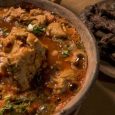
The elaboration of the dishes is homemade, the prices are cheap and the family service.
The markets, varied and overflowing with activity from early in the morning, travel across the vast Mexican geography in the towns and cities of Mexico.
They house all kinds of products, including fruit, vegetables, handicrafts, meat, fish, beans, tortillas or shoes, and they also constitute one of the most representative epicenters of Mexican cuisine.
From her food stand at the Mercado Independencia, one of the oldest and most entrenched of Morelia, capital of the state of Michoacán, the cook Arcelia Domínguez invites each of the people who pass through the corridors: ¡Pásele!, ¿qué va a comer? We serve rice soup, chicken broth and beef.
The food sector, located in the central area of Independence, brings together around 20 positions of the around 700 that make up the commercial establishment.
The space is cozy and is defined by family service and homemade dishes. The diners have a wooden bar to taste the food without haste, surrounded by burning stoves and clay casseroles with exquisite freshly made recipes, which are part of the gastronomic tradition of Michoacán and the country.
Stuffed chiles, pork, stewed beans, pork rinds in green or red sauce, torta of potato, poblano pepper slices, beef dumplings in tomato sauce, steak made in eight different ways with rice soup and vegetables. ”
This is how Domínguez lists the typical dishes he prepares every day at his place. “In total there are more than ten, with two different per day.”
To this extensive list are added the corundas, one of the most characteristic dishes of Michoacán, whose elaboration is based on corn and which are served with chile, sauce, cream and cheese.
For Yolanda Martínez, cook and in charge of a food stand for more than 20 years, “being located within the market has a great advantage.” “If they ask for something else that is not on our menu we can also prepare it quickly, because we have all the ingredients at hand in the market,” he says.
IN ADDITION, THE DIFFERENCE WITH THE RESTAURANTS, WHICH MANY TIMES USE FROZEN PRODUCTS, HIGHLIGHTS, WHILE IN THE MARKET THE FOOD IS VERY FRESH AND OF THE DAY.
Lunch in the market is traditionally served in two ways: on the one hand, “comida corrida” that includes, in addition to the main course, an entrance soup, tortillas and flavored water and, on the other hand, a unique dish. In both formats the cost is between 40 and 60 pesos (between 2 and 3 dollars).
The kitchen is open seven days a week, from eight in the morning until seven in the afternoon, following market hours. The work of the cooks is barely resting.
“The kitchen is one of the businesses most sacrificed for the constant effort and time it requires,” says Dominguez. At 52, the veteran cook is the third generation in charge of the position. His grandmother opened it 49 years ago when the market opened on December 28, 1966.
The Independence market was built on a swamp located on the perimeter of the city at that time. At present, with the rapid growth of Morelia, it is in the center.
Some of the old business practices, typical of the Purhepecha indigenous peoples, such as bartering of farm products in exchange for a lunch, are still preserved in the daily activity of the market.



